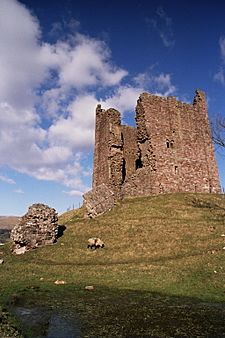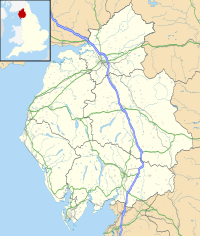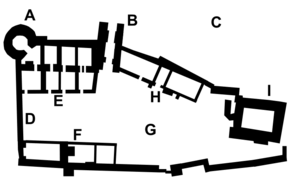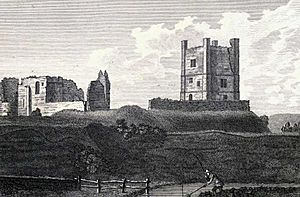Brough Castle facts for kids
Quick facts for kids Brough Castle |
|
|---|---|
| Brough, Cumbria, England | |

The ruined keep at Brough Castle
|
|
| Coordinates | 54°31′18″N 2°19′28″W / 54.5218°N 2.3244°W |
| Site information | |
| Owner | English Heritage |
| Open to the public |
Yes |
| Site history | |
| Materials | Stone |
| Events | Great Revolt of 1173-74 |
Brough Castle is a cool old ruined castle in the village of Brough, England. It was built by William Rufus around 1092. The castle was placed inside an even older Roman fort called Verterae. Its main job was to protect an important road through the Pennine Mountains.
At first, Brough Castle was a "motte and bailey" castle. This means it had a big mound of earth (the motte) with a wooden tower on top. Around it was a fenced-off area (the bailey). In 1174, Scottish forces attacked and destroyed it during a big rebellion against King Henry II. After the war, the castle was rebuilt. A strong square stone tower, called a keep, was added. The rest of the castle was also changed from wood to stone.
The Clifford family took over Brough Castle in the 1260s. They added their own tower, called Clifford's Tower. They also made many changes, turning it into a typical northern English castle. But in 1521, a huge fire broke out after a Christmas party, destroying much of the castle. It was left in ruins for a long time.
Later, Lady Anne Clifford decided to fix up the castle between 1659 and 1661. She used it as one of her homes. But in 1666, another fire happened, making the castle impossible to live in again. Brough Castle then slowly fell apart. Its valuable parts were taken, and its stone began to crumble around 1800.
In 1921, Brough Castle was given to the government. Today, English Heritage looks after it. You can visit it as a tourist attraction. It's a very important historic site.
Contents
Building Brough Castle: The Early Years
Brough Castle was built on the site of an old Roman fort called Verterae. This fort was about 3 acres big and was used until the 5th century. It guarded the Stainmore Pass, a key route through the Pennine Mountains. This pass connected the River Eden to a Roman road. That road linked Carlisle and Ermine Street, which was important for trade.
After the Norman conquest of England in 1066, William the Conqueror took control of northern England. The area around Brough became a disputed borderland between the Normans and the Scottish kings. William's son, William Rufus, invaded the north-west in 1091. He built Brough Castle around 1092. He chose the northern part of the old Roman fort. This way, he could use the existing earthworks, just like at nearby Brougham and Lancaster. The castle's north side looks over the River Eden.
The first castle was a "motte and bailey" design. The main tower (keep) had stone foundations but was mostly made of wood. The rest of the old fort became a fenced-off area (bailey). The village of Church Brough was also created around the same time. It was a planned settlement, part of the Normans settling the lowlands.
Attacks and Rebuilding: The 12th Century
The land around Brough was often fought over by the kings of England and Scotland. In 1173, William the Lion of Scotland invaded England. This was part of a big rebellion against King Henry II. William's army moved south. They tried to take Wark and then Carlisle, but failed. They did capture Appleby before heading to Brough.
Brough Castle was defended by six knights. They fought bravely, but William's forces broke through the outer defenses. They then surrounded the keep. William threatened to kill the soldiers inside if they didn't surrender. The keep was set on fire, forcing the defenders to give up. One knight, according to a writer named Jordan Fantosme, kept fighting with spears and then wooden stakes until he was finally overwhelmed. William then destroyed the rest of the castle's defenses using mercenary troops from Flanders. Later that year, Henry II's forces defeated William. Brough Castle was taken back by the English.
After the war, King Henry II ordered a new square stone keep to be built in the 1180s. This work was done by Theobald de Valoignes and then Hugh de Morville. They rebuilt the castle's remains. The new keep was placed within the bailey wall. This allowed it to directly support the outer defenses. More work was done between 1199 and 1202 for King John. This turned the entire castle into stone.
Clifford Family and Castle Changes: 13th-15th Centuries
In 1203, King John gave the lordship of Westmoreland, including Brough, to Robert de Vieuxpont. Robert made the castle bigger to show his power in the region. He was competing with other family members for control. Robert died in 1228. His young son, John, inherited the castle. But John died fighting in the Second Barons' War (1264-1267). His lands were split between his two daughters. Isabel de Vieuxpont got Brough. King Henry III gave some of her lands to Roger de Clifford. Roger then married Isabel, getting all her lands. This started a long period of the Clifford family owning the castle.
The Cliffords managed to bring all the old Vieuxpont lands back together by 1333. They controlled the Eden valley with their castles at Appleby, Brougham, Pendragon, and Brough. Robert Clifford took control of Brough around 1308. He made the defenses better, rebuilding the east wall. He also built a new great hall and his own rooms in a new round tower, called Clifford's Tower.
Robert died fighting the Scots at the Battle of Bannockburn. The area around the castle was attacked in 1314 and 1319. This caused a lot of damage to nearby Church Brough. Around this time, the village of Market Brough was created. It was built along the road near the castle. The Cliffords wanted to make more money from trade along the valley. Market Brough got a special royal permission in 1330. It quickly became the main settlement in the area.
In the 1380s, Roger, the fifth baron, decided to change the castle. He wanted to improve its defenses. Roger worked on most of the Clifford castles in the area. At Brough, he rebuilt the south wall and updated the living areas. He replaced the old hall with a more modern hall and chamber block on the first floor. Clifford's Tower was changed into bedrooms. These changes at Brough showed the popular castle style in northern England at the time. They favored square shapes and towers over the rounder designs popular in the south. The castle's courtyard was also paved with stones around this time.
The gatehouse was made stronger with supports. An extra courtyard was built inside the bailey around 1450. This was possibly done by Thomas Clifford. During the Wars of the Roses, a fight between the Lancastrians and Yorkists, the Cliffords supported the Lancastrians. Thomas died in 1455, and his son John died in 1461. Brough was taken from the Cliffords by the Yorkists for a while. But John's son Henry got his lands back in 1485 from King Henry VII.
Fires and Restoration: 16th-17th Centuries
Henry Clifford used the castle until 1521. That year, a fire broke out after a big Christmas feast. It destroyed the parts of the castle that people lived in. Henry died soon after, and the castle stayed in ruins for many years.
The castle was fixed up in the 17th century by Lady Anne Clifford. She was a very important landowner in the Clifford family. She moved back to the north during the time of the Commonwealth, after the English Civil War. Even though Anne supported the king, she had powerful friends. This allowed her to enjoy her properties freely. She rebuilt several Clifford castles, including Brough. She worked on Brough between 1659 and 1661. Anne did more work at Brough than anywhere else. She wanted to make it look like it did before the 1521 fire.
Anne knew about new building styles. But her restoration work was quite traditional. She used existing northern castle architecture. She even tried to bring back 12th-century features in the keep. As part of this work, new windows were added. A ground-floor entrance to the keep was built. New service rooms were installed so she could live comfortably. By 1665, the castle had 24 fireplaces!
Anne called Brough's keep "the Roman Tower." She believed the Romans had built it. She spent her time at the castle living in Clifford's Tower and, as work continued, in the keep. By 1665, she was able to spend Christmas at the castle for the first time. However, in 1666, another fire hit the castle. It made the castle impossible to live in again. After the fire, the remaining buildings in the bailey were used as a law court. Anne died in 1676, and the castle was never fully restored.
Decline and Preservation: 18th-21st Centuries
Anne's daughter, Margaret, married John Tufton. John's son, Thomas, took parts from Brough Castle around 1695. He used them to help rebuild Appleby Castle. The castle's furniture was sold in 1714. In 1763, much of the stone from Clifford's Tower was taken to build Brough Mill. After this, the castle was completely abandoned. The south-west corner of the keep partly fell down around 1800.
In 1920, more of the south-west corner collapsed. The castle's owner, Lord Hothfield, gave the property to the government. Work was done to make the ruins stable. The castle, as a listed building and ancient monument, eventually came under the care of English Heritage. Now, it's a tourist attraction. Archaeologists did excavations there in 1925, and again in 1970–71, 1993, 2007, and 2009. The castle's stone is still wearing away. As of 2010, English Heritage said the castle's condition was getting worse. Some parts were especially at risk.
Images for kids
See also
 In Spanish: Castillo de Brough para niños
In Spanish: Castillo de Brough para niños










